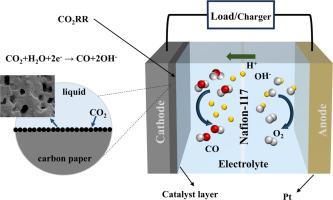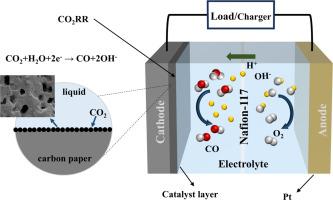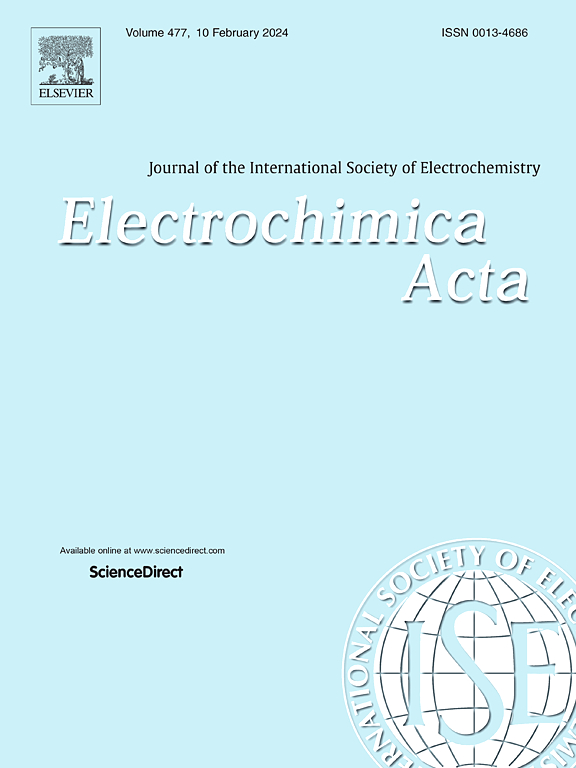Electrolytic conversion of CO2 to proportionally tunable syngas using nickel-nitrogen doped carbon materials derived from Chlorella sp.
IF 5.5
3区 材料科学
Q1 ELECTROCHEMISTRY
引用次数: 0
Abstract
Chlorella sp., a common type of algae found in global surface waters, is prone to causing "blooms" and can accumulate significant amounts of nutrients such as nitrogen, phosphorus, and carbon. While carbon materials derived from Chlorella sp. are widely used in the field of adsorption, there are relatively few reports focused on electrocatalysis. This study utilized Chlorella sp. as a raw material to synthesize functional carbon materials, and prepared nitrogen-doped (CN), nickel-doped (CNi), and nitrogen-nickel co-doped (CNNi) carbon-based catalysts with both metal and non-metal elements. The results showed that the CN, CNi and CNNi catalysts possessed certain electrocatalytic properties, among which the CNNi material had the best electrocatalytic activity towards CO2 reduction (CO2RR). In 1.0 M KHCO3, the CNNi catalyst exhibited an instantaneous current density of 15.4 mA/cm2 under the potential of -0.82 V (vs. RHE). In terms of product selectivity, the Faraday efficiency of CO on the CNNi electrode was up to 90 % when the electrode potential was -0.62 V (vs. RHE), while the selectivity of the CN and CNi catalysts for CO was only 59 % under the optimal conditions. The co-doping of nitrogen and nickel significantly enhanced the electrocatalytic activity and the selectivity towards CO of Chlorella-based carbon materials.


使用从小球藻提取的掺镍氮碳材料电解转化二氧化碳为比例可调的合成气
小球藻是全球地表水中常见的一种藻类,容易引起 "水华",并能积累大量营养物质,如氮、磷和碳。虽然从小球藻中提取的碳材料被广泛应用于吸附领域,但有关电催化的报道却相对较少。本研究以小球藻为原料合成功能碳材料,制备了掺氮 (CN)、掺镍 (CNi) 和掺氮镍共 (CNNi) 金属和非金属元素的碳基催化剂。结果表明,CN、CNi 和 CNNi 催化剂都具有一定的电催化特性,其中 CNNi 材料对二氧化碳还原(CO2RR)的电催化活性最好。在 1.0 M KHCO3 中,CNNi 催化剂在电位为 -0.82V 时的瞬时电流密度为 15.4 mA/cm2(相对于 RHE)。就产物选择性而言,当电极电位为 -0.62 V(相对于 RHE)时,CNNi 电极上 CO 的法拉第效率高达 90%,而在最佳条件下,CN 和 CNi 催化剂对 CO 的选择性仅为 59%。氮和镍的共掺杂显著提高了小球藻基碳材料的电催化活性和对 CO 的选择性。
本文章由计算机程序翻译,如有差异,请以英文原文为准。
求助全文
约1分钟内获得全文
求助全文
来源期刊

Electrochimica Acta
工程技术-电化学
CiteScore
11.30
自引率
6.10%
发文量
1634
审稿时长
41 days
期刊介绍:
Electrochimica Acta is an international journal. It is intended for the publication of both original work and reviews in the field of electrochemistry. Electrochemistry should be interpreted to mean any of the research fields covered by the Divisions of the International Society of Electrochemistry listed below, as well as emerging scientific domains covered by ISE New Topics Committee.
 求助内容:
求助内容: 应助结果提醒方式:
应助结果提醒方式:


